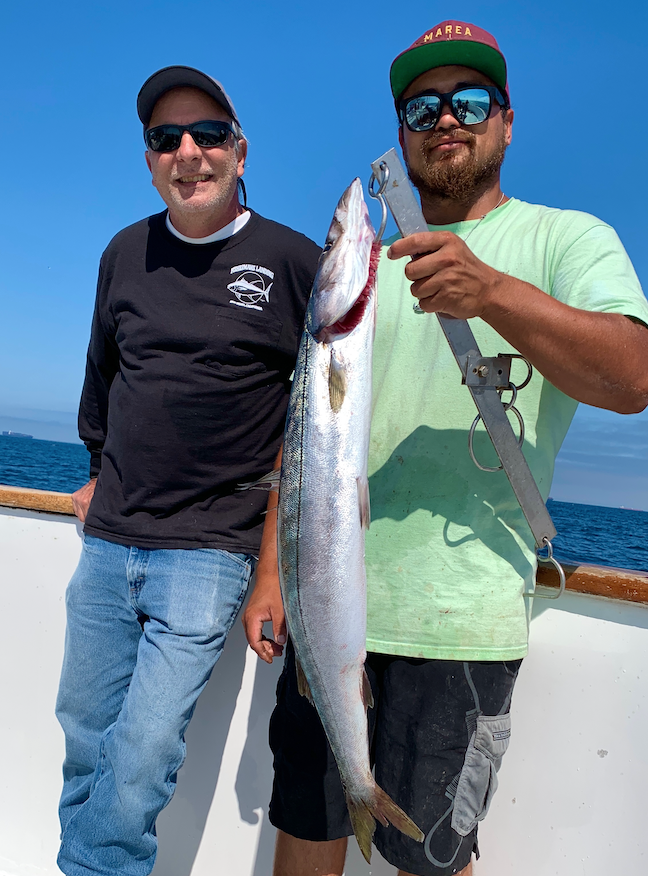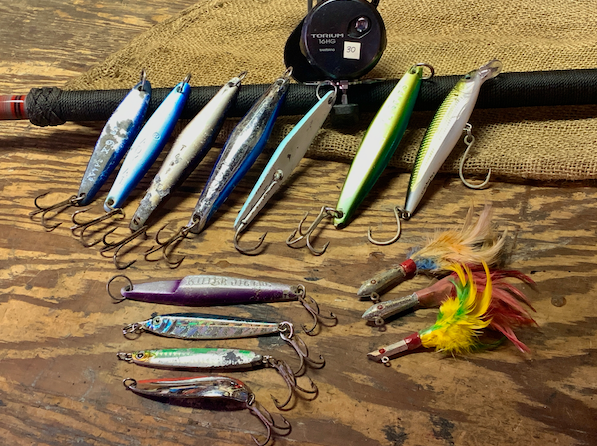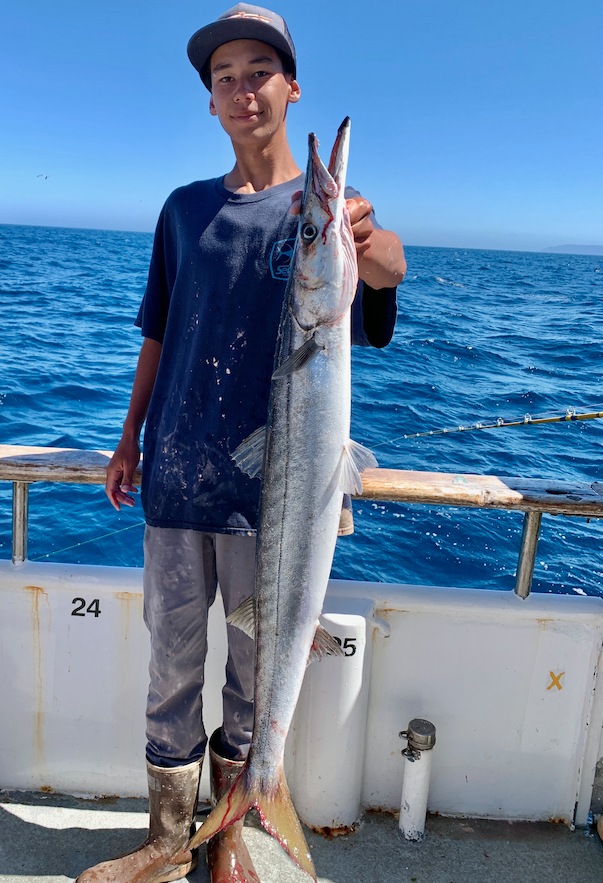
BY JON DICKENS
While bluefin, seabass and yellowtail are still getting the headlines, anglers who fish the ½-day and ¾-day party boats, or from their own boats, are starting to think about that infamous band that rocks their world, the “Three B’s”…bass, bonito and barracuda. With warming water temps and more anchovies showing up for bait than in recent years, the hope is that we’re on the cusp of some fun local fishing.
Each of these three species are great light tackle fish, but the barracuda is known to get more people off their couch and onto the water than the rest. And for good reason. They’re aggressive biters that show up in large schools, attack both live bait and lures and are great on the barbecue.
Barracuda fishermen typically begin watching the fish counts for their arrival at the end of May. In years past, when the barries showed up, there seemed to be a three-day window to the bite. If you didn’t get out there during that time, the fish would move and it could take a while to relocate them or for another school to move in. Timing was key. We’ll see if that holds true again this season.
Memorial Day barracuda blitz
My fondest memory of catching barracuda was when I was in my early teens and used to take the bus to Manhattan Beach Pier. I remember getting off the bus one Memorial Day and rounding the corner to see what appeared to be the entire SoCal party boat fleet and dozens of private boaters right out in front of the pier. I knew something must have been biting wide-open to draw boats from Long Beach to Malibu.
I ran as fast as I could all the way down Manhattan Beach Blvd. and out to the end of the pier, to find anglers hooked up or trying to bounce log barracuda averaging 7- to 8-pounds over the railing of the pier. Easier said than done.
I quickly joined the party, fired out a jig and immediately hooked up, but the big barracuda inhaled the jig and bit me off. I looked for a bigger jig in my box and got bit again. Weaving over and under other fishermen’s lines, I finally had my prize straight up and down.
Then the question was do I attempt to reel it up, hand line it or wait for a net. There was one hoop-shaped landing net on the pier, usually used for the occasional halibut, which was dropped on a rope down the 20-feet or so to the water. The trick was trying to pull your barracuda over it so it could be quickly scooped up, and hope that it stayed in for the ride up onto the pier. Not all of them made it. Some were still too green and shimmied out of the shallow net on the way up.
The other problem was keeping your fish on the line while waiting for your turn for the net. Most didn’t wait and tried to manhandle the fish up from the water and with a mighty heave, bounce the fish over the rail. Not easy to do with an 8-pound log on 20-pound line, as I soon found out. Say goodbye to fish number two, but I finally got the hang of it.
My Dad arrived at noon to pick me up to go to a family barbecue and when I wasn’t waiting in front of the pier as instructed, he came looking for me and saw the pandemonium going on. I excitedly said, “Dad, go home and get another rod! This bite is unbelievable!” He declined but volunteered to clean my four barracuda lying behind me and said then we’d have to go.
Of course I couldn’t just stop fishing and shortly added another barracuda to the cleaning table, and then another before he said in his empathetic Father Knows Best tone, “Sorry son, you’re done for the day. We have to go.” Without the prior family commitment, he probably would have made a few casts himself, but dads have to do what dads have to do. It hurt having to leave in the midst of a wide-open barracuda bite, but it inspired me to want to catch more in the future.
How to catch barries on the iron
While live bait catches plenty of barracuda, most seasoned anglers prefer the iron. Many jig slingers got their first taste of how to catch a fish on the iron from fishing for barracuda. It’s the perfect fish to learn the nuances of jig fishing and a great confidence builder.
When the barracuda are boiling within casting distance and slashing at anything that looks like a meal, catching them on the iron can be relatively easy if you understand the basics. When they’re being picky, that’s when skill and experience come into play.
Novice anglers find that using a spinning rod and reel is the easiest to cast a lure with and there have been significant improvements in the reels that used to be known as coffee grinders. Casting distance and accuracy are easier to achieve with spinning gear, but most anglers opt for a 9- to 10-foot jig stick, a 16 or 20 size Shimano, Daiwa or similar brand star drag reel, with 30- to 40-pound test monofilament line.
Of course there are lots of options for rods and reels and everyone has their favorites, but unless you’re a devout jig slinger, don’t get too hung up on having the perfect rod and reel. That’s but a small part of the equation.

Focus on the birds
Jig fishing for any species, barracuda included, is more about knowing where and when to cast than what kind of tackle you have. Focus on the birds. They’ll tell you where the fish are. If you see a tern or sea gull dip down to the surface, there’s probably baitfish being pushed up by predator fish below it. That’s your target. Of course if the fish are boiling, that makes your target easier to spot. Try to anticipate if the fish are moving in a particular direction and put your cast where they’ll be rather than where they are. Not always possible.

Most party boats require jig fishing to be done from the house or cabin forward to the bow so as not to interfere with the bait fishermen. Most will fire away from the bow where there’s more casting room. Regardless of where you cast from, remember safety first. The ocean isn’t moving, but your jig is. ALWAYS look behind you when casting and watch your jig until you release your line from the reel spool. Someone may unexpectedly walk into your back cast. When the action heats up and the fish are boiling, people tend to throw caution to the wind and get careless. Don’t be that guy that hooks someone. It’s a horrible feeling. For both parties.
The biggest jig fishing mistake and tips to hook more barries
Without a doubt, the mistake most novice and experienced jig fishermen make is reeling too fast. Sometimes it’s due to excitement, sometimes just not knowing that barracuda generally like a slow to medium speed retrieve. Every model jig swims differently but when in doubt, slow it down. Here are a few more tips that will get you bit in a scratchy bite…

WIND AND CRANK: When you get bit on the iron, don’t swing to set the hook, just keep winding or wind a little faster to set the hook. Once hooked, do NOT pump the rod. Given any slack line, the cuda will throw the hook. Just straight wind it to the boat and wait for a gaff or carefully bounce it over the rail.
STOP AND GO: A technique I’ve found that often triggers a bite is to give your reel a couple of hard or faster cranks during your slow retrieve. Sort of a stop-and-go pattern. That change in speed imitates a scared or dying baitfish that is sometimes irresistible to barracuda.
LET IT SINK: If the fish are up and boiling on the surface but you’re not getting bit, or getting smaller fish, try letting your jig sink down to 20 feet or so before retrieving. The bigger/smarter fish sometimes wait for injured baits to filter down in the water column and scarf them up.
NOT COMMITTING: If you see them chasing your jig or you’re getting bumped but they’re not committing, change your retrieve speed, let it sink out more or change your jig. Action is always more important than color but sometimes there may be a hot color, like blue and white, black and white, or green and yellow. I like a Tady 45 or Salas 7X, especially if big fish are around but if they won’t bite it go to smaller size jigs like a Tady C or AA. Colt Snipers and MegaBaits that have a sardine or anchovy profile are also effective. If you’ve got a jig that’s been bit so many times that the paint is almost gone, use it. The action is likely why it got bit and losing its paint won’t stop it from getting bit again.
COPY WHAT’S WORKING: Always ask the deckhands what’s been the hot ticket on the way out. What model jig, what size, color, retrieve speed, etc. They’re out there everyday and they know what’s working. If people are getting bit during the day and you’re not, ask for help from the deckhand or a hot stick. That’s how you learn. I’ve been fishing for many years and I still ask questions each trip. Experience helps but doesn’t supersede what the crew can tell you.

DO SOMETHING DIFFERENT: Not biting the standard jigs? Try a plastic swimbait, Hookup Bait, or crankbait. They may get chewed up due to a barracuda’s dentures, but it might be worth it. Or go old school. Back in the day, the hotshots added a thin wire leader to get better action out of their jigs. They also used wire with the Yankee feather jigs that had an elongated chrome leadhead with feathers in blue and white or other combos, which they retrieved with a sweeping motion. Worked back then, probably would work again.
GO DOWN IN LINE TEST: If you’re fishing a smaller or lighter jig, sometimes going to 25-pound test or even 20-pound monofilament will give your jig more action and allow you to cast it further. Most anglers fish straight mono or a topshot of mono longer than your longest cast.
ALWAYS CHECK YOUR LINE: After every barracuda caught or missed, check for frays or chafed line. Make it a habit to retie when the slightest fray is detected, or you can count on losing your next fish.
Jig fishing for barracuda is addicting, especially when they go full tilt. Just remember to be careful casting and when bouncing your fish over the rail. No one wants a misguided hook or a face full of cuda slime ruining their day.



